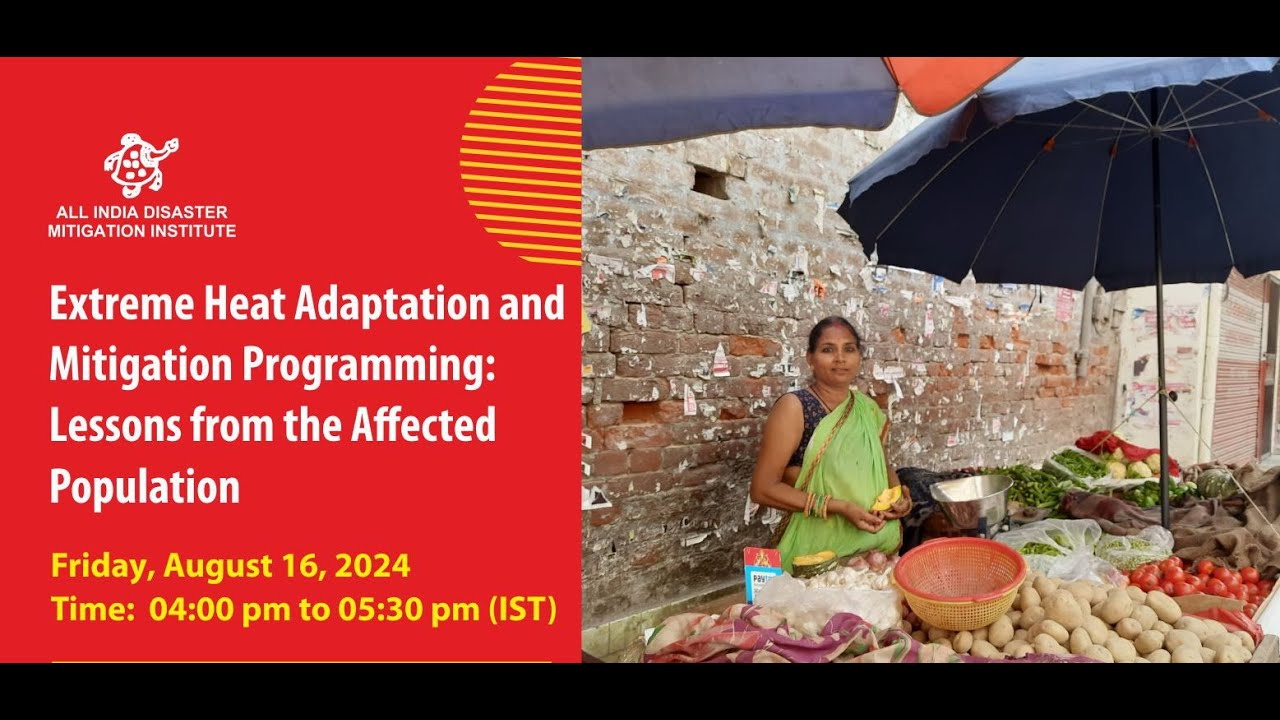Extreme heat adaptation is becoming increasingly crucial as climate change amplifies temperature extremes across the globe. In places like Ahmedabad, India, citizens are grappling with rising heat levels, prompting the development of comprehensive heat action plans to safeguard public health and worker safety. The impact of these climate changes is visible not just during extreme heat events but also in the cumulative effects on people’s daily lives. Urban heat management strategies are vital in these contexts, requiring data and collaboration between researchers and community leaders. Innovative studies, such as the Ahmedabad heat study, aim to provide the insights needed to build resilience against the dangers of extreme heat, particularly for vulnerable populations.
Heat adaptation strategies encompass a range of approaches designed to mitigate the effects of rising temperatures on urban populations. As extreme climatic conditions worsen, cities are increasingly focused on developing initiatives tailored for heat management, especially benefiting informal workers exposed to these challenges daily. The focus on worker health and safety is central to these efforts, as harsh weather conditions not only affect productivity but also pose serious health risks. Collaborations between researchers and community organizers are key to gathering accurate data on climate change impacts, informing policy solutions that acknowledge the unique needs of those most at risk. Initiatives like community-based heat studies exemplify a proactive response to climate challenges, aiming to empower vulnerable populations with practical adaptation measures.
The Urgent Need for Heat Action Plans
As climate change intensifies, the frequency and severity of heatwaves are becoming a critical challenge that communities worldwide must address. Heat action plans play a pivotal role in urban heat management, forming a framework to articulate clear strategies for minimizing heat-related health risks. These plans outline essential initiatives like public awareness campaigns, access to hydration, and temperature monitoring to protect vulnerable populations, particularly informal workers who often lack adequate resources and support. In Ahmedabad, the implementation of the first heat action plan in South Asia serves as a pioneering example, demonstrating that systematic approaches can help mitigate the impacts of extreme heat.
However, despite the existence of these plans, there remains a significant gap in their effectiveness due to the underreporting of heat-related health issues and deaths in urban settings. This is mainly because many heat-related fatalities are often misclassified as heart attacks or other medical emergencies. Therefore, it is essential for communities to push for more comprehensive heat action plans that are inclusive of all workers, as inadequate coverage can exacerbate the challenges faced by those who are most at risk. Properly integrating high-quality data into heat action plans can empower civil society to advocate for pragmatic policy modifications that recognize and address the realities of urban heat exposure.
Extreme Heat Adaptation Strategies
The key to mitigating the adverse health impacts of extreme heat lies in developing effective adaptation strategies that can be tailored to local conditions. In Ahmedabad, researchers are investigating various degrees of adaptation, including home design improvements, heat-reflective surfaces, and insurance models that provide financial support during extreme heat events. As community members engage in these adaptation practices, it becomes critical to harness data collected through sensors and health monitoring devices to observe the real effects of these strategies. By understanding how these adaptations impact worker health and productivity, urban planners can implement more effective solutions to preserve worker health safety in extreme heat.
Furthermore, building resilience among workers is essential for long-term adaptability. Systems such as parametric heat insurance provide financial security, enabling workers to stay at home without facing the dilemma of lost wages during unbearable heat. This innovative approach demonstrates how financial tools can complement physical adaptations, such as shade installations or reflective roofing, creating a comprehensive strategy to combat extreme heat. As Ahmedabadi women increasingly purchase such policies, it highlights a growing awareness of the need for solutions that not only provide immediate relief but also promote sustainable adaptation practices in the face of climate change.
Understanding the Climate Change Impact
Climate change significantly amplifies the intensity of extreme heat events, leading to dire consequences especially for the most vulnerable populations. Studies indicate that urban areas like Ahmedabad are experiencing average temperature increases that exceed those measured at standard weather stations, creating a discrepancy that can underestimate true heat exposure. This data highlights the need for a better understanding of microclimates — localized areas that may experience greater heat due to poor urban planning, like inadequate ventilation in homes and concrete-block structures that trap heat. Understanding these climate change impacts is essential for crafting effective policies and interventions.
Moreover, the increase in frequency of heatwaves correlates with higher incidences of heat-related illnesses, particularly among unregulated informal workers who lack protective measures. The ongoing research aims to collect details on human heat exposure and its physiological effects, thereby filling the data gaps regarding how climate change influences health and safety. By working closely with local communities, scientists can better assess the climate change impact, tailor their approach to mitigation strategies, and advocate for policies that serve to protect populations from the fast-evolving challenge of extreme heat.
Data-Driven Insights in Urban Heat Management
The use of data collection methodologies is revolutionizing the way urban heat management is approached in cities like Ahmedabad. By placing sensors in the homes and workplaces of participants, researchers are able to build one of the most comprehensive datasets on extreme heat and its health impacts. These insights are invaluable as they provide a clearer picture of how urban environments contribute to heat stress and can inform interventions designed to create healthier living conditions. This data-driven approach ensures that decision-makers are equipped with the necessary information to develop targeted strategies that effectively address the unique challenges faced by local populations.
Furthermore, this focus on empirical data gathering helps to bridge the gap between scientific research and community needs. It empowers local residents to take an active role in monitoring their environments, thus fostering a sense of ownership over their health and safety. When communities have access to accurate climate information, they can advocate more effectively for the policies that protect their welfare. This participatory model represents a significant shift towards inclusive governance in heat action plans, highlighting the importance of community involvement in urban heat management.
Protecting Worker Health and Safety
Worker health safety is paramount in environments increasingly affected by extreme heat. Ensuring that laborers can perform their jobs without risking their well-being is becoming an urgent matter. The vulnerabilities of informal workers — those who typically work outdoors and often without safeguards — are magnified during heatwaves, leading to higher chances of heat exhaustion and other serious health conditions. This highlights the critical necessity for implementing effective training and safety measures tailored to high-risk occupations where prolonged exposure to heat is inevitable.
Moreover, creating supportive workplace policies that address heat stress is essential for promoting worker health safety. This could involve introducing flexible work hours that allow workers to perform tasks during cooler parts of the day or providing access to shaded rest areas and hydration stations. By prioritizing the health and safety of workers, cities can promote more sustainable labor practices and increase overall productivity — fostering a healthier workforce that can thrive even in challenging heat conditions.
Innovative Solutions from Community Engagement
The collaboration between Harvard researchers and grassroots organizers in India exemplifies how community engagement can lead to innovative solutions. Through direct involvement with local populations, researchers gain unique insights into the lived experiences of those facing extreme temperatures. This partnership emphasizes the importance of delivering tailored strategies that resonate with the needs of those who are directly impacted by heat stress, rather than imposing top-down solutions that may not consider local contexts.
Community response initiatives, such as promoting heat-reflecting materials for roofing or providing umbrellas for street market vendors, effectively illustrate how collective action can address the immediate challenges of climate adaptation. Moreover, sharing knowledge and best practices empowers communities to take initiative in their heat action plans. By adopting locally-developed strategies, neighborhoods can enhance their resilience against increasingly intense heat and ensure greater inclusivity and effectiveness in adaptation efforts.
The Role of Technology in Heat Adaptation
Technological innovations are playing an integral role in addressing the challenges presented by extreme heat. The deployment of portable sensors in homes and workplaces facilitates real-time temperature and humidity monitoring, producing granular data that can drive policy changes and local adaptations. These advancements allow for a greater understanding of environmental hazards that ordinary people face daily. As researchers analyze this data, they can propose more effective urban planning solutions tailored to the specific microclimates and heat extremes observed in different neighborhoods.
Moreover, wearable technology, such as Fitbits, is proving essential for health monitoring during extreme heat events. By tracking individuals’ physical responses to heat exposure — like heart rates and activity levels — researchers can compile data that highlights the effects of climate change on worker health. This merger of health and environmental data not only enhances the understanding of heat adaptation strategies but also informs public health initiatives aimed at protecting vulnerable populations during heatwaves.
Empowering Women Through Resilience Strategies
Women, particularly in low-income communities, face unique challenges in adapting to extreme heat. Many women are primary caregivers and tend to work in the most heat-exposed settings, such as markets or agriculture, where access to cooling resources is limited. Empowering these women through resilience strategies, such as the introduction of heat insurance policies, can significantly alleviate the pressure they face during extreme heat periods. This enables them to make necessary choices about their health and livelihoods, paving the way for greater autonomy and protection.
Moreover, fostering women’s participation in heat action plans is crucial for developing holistic strategies that consider the experience of half of the population. Including women in decision-making processes not only ensures their needs are met but also strengthens community resilience overall. As women adopt and implement strategies specific to their experiences, they become central figures in driving community adaptation efforts, showcasing the integral role of gender equity in combating the adverse effects of climate change.
Challenges and Future Directions in Heat Mitigation
While heat action plans and adaptation strategies are evolving, significant challenges remain in their implementation across various urban landscapes. One persistent issue is the disparity in data availability and accuracy of reporting heat-related health impacts across regions. Addressing these challenges will require collaboration between governments, researchers, and community organizations to develop standardized protocols for data collection and reporting that accurately reflect the lived experiences of vulnerable populations.
Additionally, as climate change escalates, cities will need to continuously adapt their strategies to respond to increasing temperatures and their health impacts. Future research should prioritize longitudinal studies that track the effectiveness of implemented strategies over time and across diverse environments. By continually refining these measures and incorporating community feedback, urban planners can establish more effective and adaptive heat action plans conducive to evolving climate realities.
Frequently Asked Questions
What are extreme heat adaptation strategies in urban heat management?
Extreme heat adaptation strategies in urban heat management involve creating policies and infrastructure to mitigate the effects of high temperatures in cities. This includes developing heat action plans that focus on vulnerable populations, enhancing green spaces, promoting reflective building materials, and improving access to cooling systems. By applying these strategies, cities can better protect residents from climate change impacts.
How does climate change impact extreme heat and worker health safety?
Climate change intensifies extreme heat events, leading to higher temperatures that can jeopardize worker health safety. Workers exposed to extreme heat risk heat-related illnesses such as heat exhaustion and heat stroke. It is crucial for organizations to implement safety protocols, educate employees about heat risks, and develop heat action plans that specifically address the health challenges posed by rising temperatures.
What role do heat action plans play in extreme heat adaptation?
Heat action plans are essential for extreme heat adaptation as they outline proactive measures to protect communities during heatwaves. These plans typically involve public education, emergency response strategies, increased access to hydration, and cooling centers. By effectively implementing heat action plans, cities can significantly reduce heat-related health impacts and fatalities among their populations.
What insights have been gained from the Ahmedabad heat study on extreme heat adaptation?
The Ahmedabad heat study has provided valuable insights into the severity of urban heat exposure and its health impacts on informal workers. It revealed that indoor temperatures can reach extreme levels, often exceeding recorded outdoor temperatures. The findings emphasize the need for tailored extreme heat adaptation strategies that consider local microclimates and the unique challenges faced by urban workers in extreme heat conditions.
Why is urban heat management critical in the context of climate change adaptation?
Urban heat management is critical in climate change adaptation because cities are increasingly facing rising temperatures due to climate change. Effective urban heat management reduces heat-related illnesses and elevates overall public health resilience. Strategies to lower urban temperatures, such as increasing vegetation cover and implementing reflective materials, can help communities adapt and thrive despite extreme heat conditions.
What innovative approaches are being used for worker health safety in extreme heat conditions?
Innovative approaches for worker health safety in extreme heat include the introduction of parametric heat insurance, which provides financial support during extreme heat events, allowing workers to stay home without loss of income. Additionally, initiatives like training for recognizing heat-related illnesses and providing resources for climate-resilient practices are being implemented to safeguard worker health during periods of extreme heat.
| Key Points |
|---|
| Harvard researchers are collaborating with grassroots organizations in India to gather data on extreme heat adaptation. |
| Extreme heat is affecting cities like Ahmedabad, resulting in severe health risks for workers, particularly in informal sectors. |
| The urban microclimates in places of residence are not accurately reflected by official temperature readings. |
| Innovative adaptation strategies include using heat-reflective roofs, parametric heat insurance, and awareness campaigns. |
| Data from heat and humidity sensors help understand personal health impacts, leading to more effective adaptation policies. |
| Community involvement is crucial for effective adaptation strategies and accurate data collection. |
| There is a significant underreporting of heat-related health issues, complicating the development of effective action plans. |
Summary
Extreme heat adaptation is a critical concern as climate change increases the frequency and intensity of heatwaves globally. Thousands of workers, especially in vulnerable communities, face life-threatening conditions due to extreme temperatures. In India, researchers are gathering vital data to understand the impacts of heat on everyday life, and this information is essential for creating effective policies and adaptation plans. By utilizing innovative solutions and involving local communities, we can pave the way for sustainable practices that protect health and enhance resilience against severe heat.









